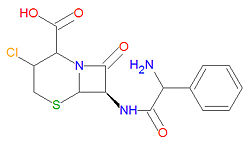Cefaclor: Difference between revisions
Jump to navigation
Jump to search

imported>David E. Volk mNo edit summary |
imported>David E. Volk No edit summary |
||
| Line 1: | Line 1: | ||
{{subpages}} | {{subpages}} | ||
{{Chem infobox | {{Chem infobox | ||
|align=right | |align=right | ||
| Line 15: | Line 18: | ||
}} | }} | ||
'''Cefaclor''', also spelled as '''cephaclor''', is | |||
'''Cefaclor''', also spelled as '''cephaclor''', is an [[antibiotic]] drug. | |||
== Chemistry == | == Chemistry == | ||
The IUPAC chemical name for cefaclor is (6R,7R)-7-[(2-amino-2-phenylacetyl)amino]-3-chloro-8-oxo-5-thia-1-azabicyclo[4.2.0]oct-2-ene-2-carboxylic acid, and it has chemical formula C<sub>15</sub>H<sub>14</sub>ClN<sub>3</sub>O<sub>4</sub>S giving it a molecular mass of 367.8074 g/mol. | The IUPAC chemical name for cefaclor is (6R,7R)-7-[(2-amino-2-phenylacetyl)amino]-3-chloro-8-oxo-5-thia-1-azabicyclo[4.2.0]oct-2-ene-2-carboxylic acid, and it has chemical formula C<sub>15</sub>H<sub>14</sub>ClN<sub>3</sub>O<sub>4</sub>S giving it a molecular mass of 367.8074 g/mol. | ||
== Synonyms and brand names == | |||
{{col-begin}} | |||
{{col-break|width=25%}} | |||
''Synonyms'' | |||
* CCL | |||
* Cefaclor anhydrous | |||
* Cefaclorum (Latin) | |||
* Cephaclor | |||
{{col-break|width=25%}} | |||
''Brand names'' | |||
* Alenfral | |||
* Alfacet | |||
* Alfatil | |||
* Ceclor | |||
* Ceclor CD | |||
* Distaclor | |||
* Kefral | |||
* Panacef | |||
* Panoral | |||
* Raniclor | |||
{{col-end}} | |||
Revision as of 12:34, 23 April 2008
|
| |||||||
| cefaclor (cephaclor) | |||||||
| |||||||
| Uses: | antibiotic drug | ||||||
| Properties: | |||||||
| Hazards: | see drug interactions | ||||||
| |||||||
Cefaclor, also spelled as cephaclor, is an antibiotic drug.
Chemistry
The IUPAC chemical name for cefaclor is (6R,7R)-7-[(2-amino-2-phenylacetyl)amino]-3-chloro-8-oxo-5-thia-1-azabicyclo[4.2.0]oct-2-ene-2-carboxylic acid, and it has chemical formula C15H14ClN3O4S giving it a molecular mass of 367.8074 g/mol.
Synonyms and brand names
|
Synonyms
|
Brand names
|
